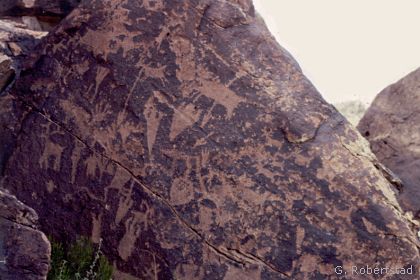



There's a rattlesnake on that rock! But no need to fear—this snake is a petroglyph. Thousands of such images painted or engraved on rock are found world-wide, including in our desert Southwest. This rock art may be more than just decoration. It depicts humans, animals, clouds, rainbows, rivers, stars, the sun, the moon, insects, directions, and spiritual concepts. Archaeologists believe some to be informative, showing where to find shelter, water, or a sacred place.
In the Southwest, petroglyphs were created by indigenous people and Europeans alike. From prehistoric times through the 19th century, our own Hueco Tanks has been visited—by Tigua, Mescalero Apache, Comanche, and others. They left behind more than 1100 figures, engraved or painted with red hematite and yellow limonite and other natural minerals.
That rattlesnake may once have communicated a vital message. We may
never know what the rock art meant to the people who created it. But the message today
is loud and clear: Petroglyphs are a precious part of our Southwestern heritage.

Contributor: Gwen Pratt, Student, University of Texas at El Paso.
Desert Diary is a joint production of the Centennial Museum and KTEP National Public Radio at the University of Texas at El Paso.

Petroglyphs, Trans-Pecos Texas. Photograph by Gordon Robertstad.
Hirschmann, F., and S. Thybony. 1993. Rock Art of the American Southwest. Graphic Arts Center Publishing Company, 128 pages.
Schaafsma, P. 1992. Rock Art in New Mexico. Revised edition, Museum of New Mexico Press, Santa Fe, 168 pages,
Desert USA about Hueco Tanks.
Texas Parks and Wildlife: Hueco Tanks
Piedra Pintada Books. An extensive list of Rock Art books.